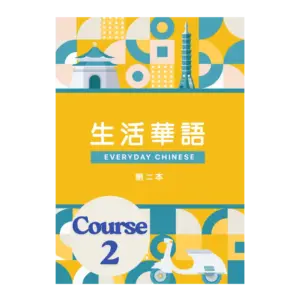
📘 Book 1 – Lesson 1
Lesson Title: 我叫馬丹尼,你呢? English Title: My name is Daniel Moreno, and you?
🎯Lesson Objective
Students will learn how to use basic greetings and introduce themselves in daily situations.
📚 Lesson Content
1. Common titles and greetings
2. Sentence patterns for introductions: “My name is…….”, “I am from…..”
3. Supplementary vocabulary related to nationalities and languages
(e.g., British, speak Chinese)
4.Use of question particles “嗎ma” and “呢ne”
📘 Book 1 – Lesson 2
Lesson Title: 請問你們要吃什麼? English Title: What do you want to eat?
🎯 Lesson Objective
Students will learn how to order food and pay at a restaurant.
📚 Lesson Content
1. Basic food vocabulary (meats and staple foods)
2. Numbers (units: ones, tens, hundreds, thousands, ten-thousands)
3. Common store names (e.g., café, bakery, etc.)
4. Common measure words (e.g., cup, bowl, bottle, etc.)
5. Question structures:
Quantity questions: 幾jǐ (how many), 多少 duōshǎo(how much)
Open-ended questions: 什麼 shénme (what)
Choice questions: 還是 háishì (A or B)
📘 Book 1 – Lesson 3
Lesson Title: 臺灣夜市有不少特別的小吃! English Title:There are quite a few special snacks in Taiwan night markets!
🎯 Lesson Objective
Students will learn how to express food flavors and their preferences toward food.
📚 Lesson Content
1. Vocabulary on beverages and night market snacks
2. Vocabulary for describing food flavors
3. Degree adverbs (e.g., a little, too [much], etc.)
4. Question structure: Two common uses of 怎麼樣zěnmeyàng (How is…? / What do you think of…?)”””
📘 Book 1 – Lesson 4
Lesson Title: 我週末常去游泳!
English Title: I often go swimming on weekends.
🎯 Lesson Objective
Students will learn how to talk with friends about hobbies and make plans to go out.
📚 Lesson Content
1. Vocabulary related to hobbies and interests (e.g., sports, watching movies, listening to music)
2. Vocabulary for time expressions (ranging from hours and minutes to full years)
3. Chinese sentence order:
How to correctly position time expressions and adverbs such as 也 yě (also) 都dōu (all) 常cháng (often)
4. Chinese sentence order: Placement of time words within sentences
5. Question structures related to time
Using 什麼時候shénmeshíhòu (when) and other time-related question forms
📘 Book 1 – Lesson 5
Lesson Title: 請問說好中文學校在哪裡?
English Title: Excuse me, where is ShuoHao Language Center?
🎯 Lesson Objective
Students will learn how to describe locations, ask for directions, and express how to reach a destination.
📚 Lesson Content
1. Vocabulary for directions and positions (e.g., up, down, left, right, etc.)
2. Vocabulary for street and traffic signs
(e.g., traffic light, crosswalk, etc.)
3. Chinese sentence order: Placement of place/location words in a sentence
4. Question structures related to location Using 哪裡 nǎlǐ (where?)
📘 Book 1 – Lesson 6
Lesson Title: 我們打算坐火車去!
English Title: We plan to go by train!
🎯 Lesson Objective
Students will learn how to ask about and describe how to get somewhere using transportation.
📚 Lesson Content
1. Vocabulary for transportation (e.g., train, bus, etc.)
2. The particle “在 zài” to indicate an ongoing action
3. Two uses of the particle “了 le”
-To indicate completed action
-To indicate a change of state or new situation
4. Comparison structures using
-比bǐ (more than),
-跟 gēn 一樣 yíyàng (the same as)
5. Question word: 怎麼 zěnme (how to + verb)
📘 Book 1 – Lesson 7
Lesson Title: 我們打算在澎湖住一個星期!
English Title: We plan to stay in Penghu for a week!
🎯 Lesson Objective
Students will learn how to describe a travel experience: where they went, what they did, and how long they stayed.
📚 Lesson Content
1. Vocabulary for accommodation (e.g., hotel, guesthouse, etc.)
2. Vocabulary for clothing and colors (e.g., red T-shirt, blue jacket)
3. Chinese sentence order: Placement of time duration expressions in a sentence
4. Alternate uses of question words: Non-committal stance using question forms
5. Question structures related to time duration Using 多久 duōjiǔ (how long?)
📘 Book 1 – Lesson 8
Lesson Title: 我的肚子很痛!
English Title: My stomach really hurts!
🎯 Lesson Objective
Students will learn how to briefly describe their symptoms to a doctor and complete a basic visit to the clinic.
📚 Lesson Content
1. Vocabulary for body parts and common symptoms
2. Vocabulary for fruits
3. Steps for visiting a doctor in Taiwan (e.g., checking in, waiting, seeing the doctor, picking up medicine)
4. Third usage of the particle “了 le” : Completion-to-date with Double 了 le
5. Alternative use of question words: All-inclusive structure using question words.
6. Comparison sentence patterns:
Using 沒有méiyǒu. 那麼nàme / 這麼zhème (not as… as)
7. Basic 把 bǎ-sentences : Introducing the structure: subject + 把 + object + verb + result
8. Question structures:
-怎麼了 zěnmele (What’s wrong?)
-為什麼 wèishénme (Why?)

pre-book

Book 2


 ShuoHao Everyday Chinese 生活華語: Book 2
ShuoHao Everyday Chinese 生活華語: Book 2 